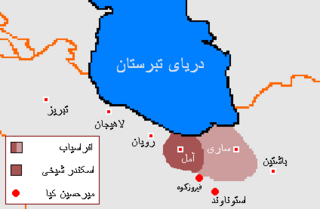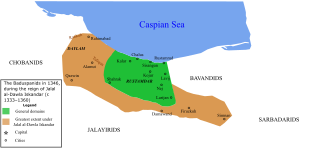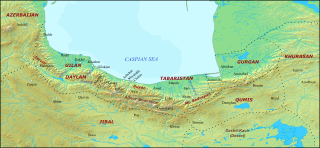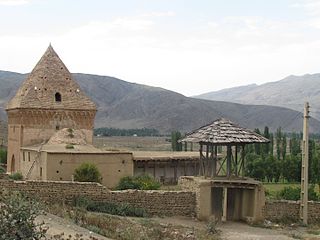
The Bavand dynasty, or simply the Bavandids, was an Iranian dynasty that ruled in parts of Tabaristan in what is now northern Iran from 651 until 1349, alternating between outright independence and submission as vassals to more powerful regional rulers. They ruled for 698 years, which is the second longest dynasty of Iran after the Baduspanids.

The Afrasiyab or Chalavi dynasty was a relatively minor Iranian Shia dynasty of Tabaristan and flourished in the late medieval, pre-Safavid period; it is also called the Kia dynasty. It was founded by Kiya Afrasiyab, who conquered the Bavand kingdom in 1349 and made himself king of the region. In 1504, Ismail I invaded Mazandaran and ended Afrasiyab rule of the region.

The Baduspanids or Badusbanids, were a local Iranian dynasty of Tabaristan which ruled over Ruyan/Rustamdar. The dynasty was established in 665, and with 933 years of rule as the longest dynasty in Iran, it ended in 1598 when the Safavids invaded and conquered their domains.
Hasan II, also known as Fakhr al-Dawla Hasan, was the last ruler of the Bavand dynasty from 1334 until his murder in 1349. He was the brother and successor of Sharaf al-Muluk.

Kiya Afrasiyab, was the founder of the Afrasiyab dynasty, ruling from 1349 to 1359.
Iskandar-i Shaykhi, was an Iranian ispahbad from the Afrasiyab dynasty, who ruled Amul as a Timurid vassal from 1393 to 1403. He was the youngest son of Kiya Afrasiyab, who had initially established his rule in eastern Mazandaran from 1349 to 1359, but was defeated and killed by the local shaykh Mir-i Buzurg, who established his own dynasty—the Mar'ashis—in the region. Together with some supporters and two nephews of his father, Iskandar initially took refuge in Larijan, but later left for Herat, where entered into the service of the Kartid ruler Ghiyath al-Din II.

Qavam al-Din ibn Abdallah al-Marashi, better known as Mir Buzurg or Mir Bozorg, was the founder of the Marashi dynasty, ruling from 1359 to 1362.
Kai Ka'us I, was the ruler of the Paduspanid dynasty from 1168 to 1184. He was the brother and successor of Shahrivash.
Vishtasp Jalali was a local Iranian ruler of Sari during the struggle that ensured after the death of the Bavandid ruler Hasan II between the local rulers of Mazandaran. He was from the Jalali family, a family native to Mazandaran which ruled Sari as governors of the Bavandids.
Hasan I, was the ruler of the Bavand dynasty from 1165 to 1173. He was the son and successor of Shah Ghazi Rustam IV. He was murdered in 1173 by his Turkic slave-soldiers (ghilman) and was succeeded by his son Ardashir I.

Ruyan, later known as Rustamdar (رستمدار), was the name of a mountainous district that encompassed the western part of Tabaristan/Mazandaran, a region on the Caspian coast of northern Iran.

Kayumarth I was the ruler (ustandar) of the Baduspanids from 1394 to 1453, with a three-year interruption. An active expansionist ruler, his kingdom experienced a resurgence during his long reign, which included the reconquest of Rustamdar. He was often at odds with his suzerain, the Timurid ruler Shah Rukh. After his death, a dynastic struggle followed, which resulted in his kingdom being split up by his sons Iskandar IV and Ka'us II, in Kojur and Nur respectively.
Awliya Allah Amuli was a 14th-century historian from Amul, who under the patronage of his Baduspanid suzerain Fakhr al-Dawla Shah-Ghazi wrote the Tarikh-i Ruyan. What little is known of his life is found in this work. At some point in his life, he made a pilgrimage to the Alid shrines in Iraq. Following the murder of the Bavandid ruler Hasan II and the collapse of his kingdom in 1349, Amuli left his native town for the Baduspanid-ruled Rustamdar, where he was allowed refuge by its ruler, Jalal al-Dawla Iskandar.
Fakhr al-Dawla Shah-Ghazi was the Baduspanid ruler (ustandar) of Rustamdar from 1360 to 1379. He is notable for sponsoring the composition of the history chronicle Tarikh-i Ruyan by Awliya Allah Amuli. He died in 1379 and was succeeded by his son Adud al-Dawla Qubad.
Adud al-Dawla Qubad was the Baduspanid ruler (ustandar) of Rustamdar from 1379 to 1381.
Sayyid Fakhr al-Din was a Mar'ashi prince, who ruled the region of Rustamdar from 1381 to 1390. He shared power with his three other brothers; Kamal al-Din I in Sari; Rida al-Din in Amul; and Sharaf al-Din in Karatughan. Together, they ruled a realm encompassing all of Mazandaran, reaching as far west to the city of Qazvin. They had inherited this realm from their father Mir-i Buzurg, the founder of the Mar'ashis.
Sa'd al-Dawla Tus was the Baduspanid ruler (ustandar) of Rustamdar from 1390 to 1394. He was a son of ustandar Taj al-Dawla Ziyar.
Taj al-Dawla Ziyar was the Baduspanid ruler (ustandar) of Rustamdar from 1325 to 1333. He succeeded to the throne after instigating the murder of his predecessor and brother Nasir al-Din Shahriyar through his son Iskandar.
Nasir al-Din Shahriyar was the Baduspanid ruler (ustandar) of Rustamdar from 1317 to 1325. He was the brother and successor of Shams al-Muluk Muhammad.
Kay Khusraw was the Baduspanid ruler (ustandar) of Rustamdar from 1301/2 to 1312/3. He was the brother and successor of Namawar Shah Ghazi.







